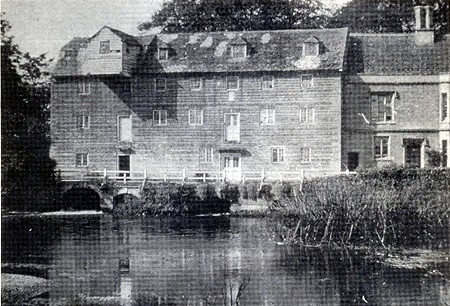|
The Deeping water
mills

The River Welland through the
Deepings has not only provided an essential trade link for cargo boats in
past times but has also powered several water mills devoted to various
commercial activities, mainly grinding corn.
A water mill is a building alongside a waterway which uses moving water as
its power source for milling, sawing or hammering, depending on which
trade is being pursued in the production of goods and materials such as
flour, paper, wood and textiles.
When the Domesday Book was compiled in 1086 there were 5,624 watermills in
England alone but over the next two centuries this number had risen to
between 10,000 and 15,000. Their demise in recent times has been equally
swift and although most have been demolished many have survived as museums
or as tasteful conversions into private homes.
The Deepings had a river trade from the earliest times but this was given
added impetus in the early 17th century when it was opened up from
Stamford to the sea, bringing added employment and prosperity during its
lifespan from 1673 until 1863 when it was probably the earliest post-Roman
commercial canal in England.
There were eventually eight water mills along this eight mile stretch of
waterway between Market Deeping and Stamford, namely Thorpe’s Mill,
(pictured above but demolished circa 1935), Molecy Mill, Hudd’s Mill and King’s Mill,
together with the mills at Maxey, Lolham, Tallington and West Deeping.
These mills have had chequered histories and in the winter of 1800,
threatening letters were sent to the millers at Molecy and Lolham
complaining about the prices being charged saying that “if you don’t
[reduce your flour] next Saturday to 3s. 6d. per stone we will [pull] your
mill down over your head and take your [flour] away”, although in the
event the protest came to nothing after being reported to the King.
Then shortly before Christmas 1880, Lolham
Mill was badly damaged by fire together with large stocks of flour and
corn, despite valiant attempts by villagers and the Deeping St James fire
engine over a period of ten hours to bring the flames under control
although a west wind helped to save the house and other adjoining
buildings.
The picturesque 18th century Molecy Mill on the outskirts of Market
Deeping dates from 1773 but with later alterations and is now attractively
modernised as a private residence. West Deeping mill dating from the early
19th century has been similarly preserved and both Grade II listed
buildings are much admired by tourists and visiting photographers.
Return to
Market Deeping

Go to:
Main Index Villages
Index
|
